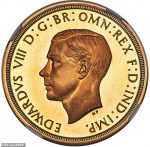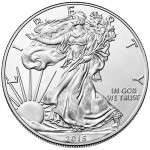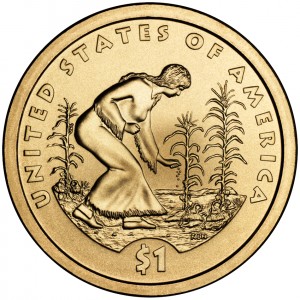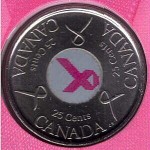Weekly World Numismatic News for March 21, 2021
Some noticed that I did not post a Weekly World Numismatic News last week. It is nice to see that so many readers are paying attention. This week, I will combine the news of the last two weeks with some highlights.
We Know Who Owns the ’33 Double Eagle
 The 1933 Saint-Gaudens Double Eagle is arguably the world’s most famous coin. The only coin of its type legal to own sold for $7,590,020 in a Sotheby/Stack’s auction to an anonymous buyer in 2002. We learned that the owner is shoe designer Stuart Weitzman and will be selling the coin along with two extremely rare stamps at an exclusive auction. The auction will include a rare plate block of the famous Inverted Jenny stamp, the holy grail for stamp collectors. Sotheby’s is estimating the coin’s value at $10-15 million. I predict it will sell for over $12 million.
The 1933 Saint-Gaudens Double Eagle is arguably the world’s most famous coin. The only coin of its type legal to own sold for $7,590,020 in a Sotheby/Stack’s auction to an anonymous buyer in 2002. We learned that the owner is shoe designer Stuart Weitzman and will be selling the coin along with two extremely rare stamps at an exclusive auction. The auction will include a rare plate block of the famous Inverted Jenny stamp, the holy grail for stamp collectors. Sotheby’s is estimating the coin’s value at $10-15 million. I predict it will sell for over $12 million.
British Coin Sells for £1 Million
 A rare gold coin with the portrait of King Edward VIII sold for £1 million. King Edward VIII was the shortest-serving monarch of the 20th century. He abdicated the throne 11 months after his coronation to marry a twice-divorced American woman. At the time, the British people felt that the divorces and her ex-husbands were living as an insult to the Church of England. Rather than fight the church, Edward gave up the throne. During his reign, the Royal Mint struck only three £5 gold coins and never circulated. The sale makes this coin the most expensive British coin.
A rare gold coin with the portrait of King Edward VIII sold for £1 million. King Edward VIII was the shortest-serving monarch of the 20th century. He abdicated the throne 11 months after his coronation to marry a twice-divorced American woman. At the time, the British people felt that the divorces and her ex-husbands were living as an insult to the Church of England. Rather than fight the church, Edward gave up the throne. During his reign, the Royal Mint struck only three £5 gold coins and never circulated. The sale makes this coin the most expensive British coin.
A Britannia of Color
 Britannia, the female allegorical symbol of Britain, is depicted on bullion coins as a woman of color. Early in U.S. coin history, Liberty has appeared in ways similar to Britannia. See the image on the Seated Liberty Dollar for an example. Following the United States’ use of a woman of color to represent Liberty, the Royal Mint mint designers produce their own. The new designs are being lauded in the cynical British press for their art and its symbolism. The Royal Mint notes that Anglo-Saxons do not dominate British territories and members of the Commonwealth Realm. It is important to understand that the coin was planned and designed before the Royal Family’s recent controversies.
Britannia, the female allegorical symbol of Britain, is depicted on bullion coins as a woman of color. Early in U.S. coin history, Liberty has appeared in ways similar to Britannia. See the image on the Seated Liberty Dollar for an example. Following the United States’ use of a woman of color to represent Liberty, the Royal Mint mint designers produce their own. The new designs are being lauded in the cynical British press for their art and its symbolism. The Royal Mint notes that Anglo-Saxons do not dominate British territories and members of the Commonwealth Realm. It is important to understand that the coin was planned and designed before the Royal Family’s recent controversies.
U.S. Wins COTY
 In case you missed it, the 2019 Apollo 11 50th Anniversary of the Moon Landing Commemorative five-ounce silver proof coin win the prestigious Coin of the Year competition. World Coin News sponsors the annual competition. Nominations, reviews, and voting are held the year following the coins’ issue. They announce the winner the following year. Aside from winning COTY, the coin won the Best Contemporary Event Coin and Best Silver Coin categories. It is one of the best designs by the U.S. Mint in recent years.
In case you missed it, the 2019 Apollo 11 50th Anniversary of the Moon Landing Commemorative five-ounce silver proof coin win the prestigious Coin of the Year competition. World Coin News sponsors the annual competition. Nominations, reviews, and voting are held the year following the coins’ issue. They announce the winner the following year. Aside from winning COTY, the coin won the Best Contemporary Event Coin and Best Silver Coin categories. It is one of the best designs by the U.S. Mint in recent years.
And now the news…
 → Read more at dailymail.co.uk
→ Read more at dailymail.co.uk
 → Read more at sothebys.com
→ Read more at sothebys.com
 → Read more at thesun.co.uk
→ Read more at thesun.co.uk
 → Read more at theconversation.com
→ Read more at theconversation.com
 → Read more at royalgazette.com
→ Read more at royalgazette.com
 → Read more at vogue.co.uk
→ Read more at vogue.co.uk
 → Read more at goodnewsnetwork.org
→ Read more at goodnewsnetwork.org
 → Read more at i.stuff.co.nz
→ Read more at i.stuff.co.nz
 → Read more at wflanews.iheart.com
→ Read more at wflanews.iheart.com
POLL: What are your gift plans?
The meaning of Black Friday and Cyber Monday has been dulled over the last few years except as an alleged barometer for the shopping season it is still something that becomes an event where the worst behaviors can be seen on the evening news. In 2013, the U.S. Mint did their part in the Black Friday hype by offering free standard shipping for the first week of the holiday shopping season.
All this means that it is the time for gift giving and gift receiving. While we are searching for the holiday deals, what is on your wish list this year? If you want to provide details, add it to the comments below!
What are your 2015 gift plans?
Total Voters: 43
Happy Thanksgiving 2015
Thanksgiving was first celebrated in 1621 by the Dutch settlers at Plymouth, Massachusetts to celebrate a successful harvest. It was a tradition that the Pilgrims brought with them from Europe. The three-day event was attended by 53 Pilgrims and 90 Native Americans that lasted three days. The tradition of giving thanks for successes was a tradition that the Pilgrims brought with them from England. This three-day celebration in 1621 is considered the first Thanksgiving.
After the birth of the United States, President George Washington issued a proclamation honoring the Thanksgiving harvest during his presidency. The only other president to issue a Thanksgiving proclamation was President James Madison. From then, it was up to the individual states to declare a Thanksgiving holiday.
Writer and editor Sarah Josepha Hale found a diary from the time of the Pilgrims and was moved to write editorials to bring back the Thanksgiving celebration. As part of her efforts, Hale developed recipes for roasted turkey, pumpkin pie, and stuffing that are part of the inspiration for today’s Thanksgiving feast. President Abraham Lincoln was so moved by Hale’s efforts that he decided that it was a good idea to maintain the union he issued a proclamation that made Thanksgiving Day a national holiday in 1863.
After Lincoln’s proclamation, it was traditional to celebrate Thanksgiving on the last Thursday of November. In a move to increase the holiday shopping period to promote more spending, President Franklin D. Roosevelt pushed to have congress pass a law to move Thanksgiving earlier in the month. In December 1941, Roosevelt signed a bill that set Thanksgiving as the fourth Thursday in November.
U.S. Mint winding down Eagle production
 As we wind down to the end of the year, the U.S. Mint has been announcing their end of the year production availability for 2015 American Eagle bullion coins. Starting with the announcement on November 14, 2015 that the quarter ounce $10 gold American Eagle bullion coin has sold out and no more will be produced. For 2015, the U.S. Mint has sold 39,500 ounces of quarter ounce American Eagle bullion coin representing 158,000 coins. This represents a 33-percent increase from 2014.
As we wind down to the end of the year, the U.S. Mint has been announcing their end of the year production availability for 2015 American Eagle bullion coins. Starting with the announcement on November 14, 2015 that the quarter ounce $10 gold American Eagle bullion coin has sold out and no more will be produced. For 2015, the U.S. Mint has sold 39,500 ounces of quarter ounce American Eagle bullion coin representing 158,000 coins. This represents a 33-percent increase from 2014.
A few days later on November 18, the U.S. Mint announced that the one-tenth ounce American Eagle gold bullion coin has been sold out. For the year, the U.S. Mint produced 980,000 of the one-tenth ounce gold American Eagle proof coins representing 98,000 ounces of gold. This year’s production is a bit more than 73-percent increase over the 565,000 coins struck in 2014.
UPDATE: In a 4:35 PM note (24-Nov-15), the U.S. Mint has announced that the one-ounce gold American Eagle bullion coin has sold out! Orders for 2016 bullion coins will begin on January 11, 2016.
The day after announcing that they will be restricting the production of the American Silver Eagle bullion coins to 1 million coins per week, the U.S. Mint announced that they will continue to produce the coins through the week of December 7, 2015. They anticipate that this will cover their full weekly allocation through Monday, December 14, 2015.
With the price of silver dropping, the U.S. Mint has produced 42,929,500 American Silver Eagle bullion coins to this point. Considering the allocation of 1 million coins per week with four weeks left of sales, the final total of silver coins should be between 46-47 million coins. This would be an increase over last year’s record of 44,006,000.
Congress is not a cure
While reviewing my notes I noticed that I had this draft in my queue. Although drafted in July, I think the topic is still relevant.
In 2009, I wrote a six-part series “Reforming America’s Currency” out of frustration with how behind the United States is in its currency production process (not economic policy) as compared with the rest of the world. After all, the U.S. Mint and the Bureau of Engraving and Printing are the largest money manufacturers in the world. In Part 4, I wrote that the “first reform in commemorative coinage would be that no commemorative would be struck for the sole purpose of raising money for any organization. Regardless of how worthy the organization may be, the association of the commemorative with fundraising taints the process.”
Nearly six years later congress presents us with a clear example of why fundraising must be eliminated from the process with the debate over the Breast Cancer Awareness Commemorative Coin Act (H.R. 2722).In an astounding partisan move, some members of congress have chosen to display their political umbrage to try to derail a commemorative coin that has bipartisan support.
If you are not aware, the original version of H.R. 2722 would have given the proceeds to the Susan G. Komen for the Cure and the Breast Cancer Research Foundation. The argument was whether money raised by the commemorative should go to Komen. As a not-for-profit charitable corporation, Komen supports education and research to fight breast cancer. The organization, founded in 1983, has been one of the more successful organizations in education and providing research funds in the fight against breast cancer.
Komen is not without controversy. Most have been within the last 10 years when the organization has grown to such size and scope that some feel it may be more corporate driven than focused on its original mission. One of its controversies is its association with Planned Parenthood. Komen, who gives grants to organization for women cancer screenings, had been proving grants to Planned Parenthood earmarked for cancer screenings. Since Planned Parenthood has also had its share of controversies, social conservatives balked at the association.
More recently, Planned Parenthood has been accused of unethical practices regarding their medical-related practices. A video surfaced that claims someone at Planned Parenthood would be selling fetal tissue following abortions. It was a hidden camera video whose contents have not been verified. Although the video has some disturbing conversations, it is unknown whether this is an isolated incident or a policy followed by some.
Because of the politics surrounding the abortion issue, the policies of Planned Parenthood, and Komen’s support of Planned Parenthood’s cancer screening programs, Komen was open to attack by right wing demagogues looking to score political points rather by using the concept of guilt by association rather than rational thinking.
In order to deal with these chest-thumping yahoos, all of whom are white men living in their own glass houses, the bill had to be amended to remove Komen from the organization receiving the money. Rather, all of the proceeds will go only to the Breast Cancer Research Foundation.Komen may have its controversies but the debate on this issue is beyond the pale. Their mission is for education and cancer research. Their mission should be as non-partisan as anything in this country. Cancer does not discriminate. Cancer will attack anyone at any time for any reason regardless of affiliation outside of being a sentient being.
To bring any other issue into the discussion, regardless of where you fall on the political spectrum, shows congress’s immaturity and that the basic function of raising money using commemorative coins should be discontinued immediately.
Some will be upset over my discussion of politics, but politics are part of the coin making process since the U.S. Mint cannot do much without permission. I also both sides of the issue, but for this debate, I do not care. When you have to go three-degrees of separation to dig up an issue in an unrelated political debate, it gets frustrating. It is yet another illustrations as to why I am against using commemorative coins to raise money for any cause regardless of how I feel about the cause—and I have personal reasons for being in favor of cancer research and education. This debate should have NEVER devolved into a discussion about abortion. The fact that it did stoop to those depths proves that congress needs to get out of the commemorative coin business. It will be one less area they can mess up.
Pennies on a hot tin roof
 Over the summer, a Harris Poll was conducted to understand how Americans feel about abolishing the one-cent coin and the paper dollar note. Even though there are pundits calling for these changes and even the end of physical currency, Harris found that those wanting to keep the lowly one-cent coin continue to hold the majority opinion.
Over the summer, a Harris Poll was conducted to understand how Americans feel about abolishing the one-cent coin and the paper dollar note. Even though there are pundits calling for these changes and even the end of physical currency, Harris found that those wanting to keep the lowly one-cent coin continue to hold the majority opinion.
Every so often an article is written, usually by the political elite, about ending lower denomination coins for many reasons including the high cost of mintage or the inconvenience of their existence. Others point to rise of non-cash transactions and the rise of digitally created currencies as the future.
Those of us who work in areas outside the larger commercial world has experience with a cash economy that is not tied to economic status. One of those is the numismatics industry. While many dealers will take credit cards, and will pass along the fees along to the customer, many dealers have said that most of their off-line business is a cash-based business. While larger purchases are done using checks, most will leave shows with more hard currency than other types of payments.
Collectibles businesses are very reliant on cash. In my business, I do accept credit cards but when I do shows the overwhelming majority of my business is in cash. A few weeks ago I did a two day show and had one of my best weekends ever but only had one sale using a credit card.There are people who are leery of using credit and debit cards for every transaction. We use cash to limit our exposure. In this connected world, the credit and debit card leaves a digital breadcrumb that is available to be hacked. I cannot tell you how many times I watched people in local convenience stores punch in their codes in a matter I could see them and then leave their receipts behind. This could be used to steal your money and your debit cards are not covered the same as credit cards. But the public does not see this.
A week does not go by without a report of the hacking of personal information that should not be made public. Unfortunately, it is getting to be like rain on the hot-tin roof, after a while the sound blends into the background.
According to the Federal Reserve, there was approximately $1.39 trillion in circulation as of September 30, 2015, of which $1.34 trillion was in Federal Reserve notes. That represents a lot of money that would have to be accounted for if we were to go into a cashless society. It would take a significant effort that would not make for good public policy.
The calls to make changes to change are beginning to drone on as background noise like rain on a hot-tin roof.








